Talyllyn Railway
| Talyllyn Railway Welsh: Rheilffordd Talyllyn | |
|
Merionethshire | |
|---|---|
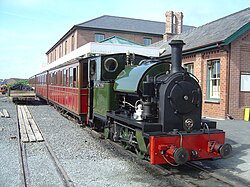 Edward Thomas at Tywyn Wharf station | |
| Gauge: | 2 ft 3" |
| Location: | 52°35’1"N, 4°5’20"W |
| No. of stations: | 7 and 5 halts |
| Track: | 7.25 miles |
| Information | |
| Operated by: | Talyllyn Railway Company |
The Talyllyn Railway is a narrow-gauge preserved railway in Merionethshire, running on a single line for 7.25 miles from Tywyn on the coast to Nant Gwernol near the village of Abergynolwyn.
The line was opened in 1866 to carry slate from the quarries at Bryn Eglwys to Towyn (as the town was spelled until recently). It was the first narrow gauge railway in Britain authorised by Act of Parliament to carry passengers using steam haulage.[1][2] Despite severe under-investment,[3] the line remained open, and in 1951 it became the first railway in the world to be preserved as a heritage railway by volunteers.[4][5]
Since preservation, the railway has operated as a tourist attraction, expanding its rolling stock through acquisition and an engineering programme to build new locomotives and carriages. In 1976, an extension was opened along the former mineral line from Abergynolwyn to the new station at Nant Gwernol. In 2001, the preservation society celebrated its 50th anniversary, and in 2005 a major rebuilding and extension of Tywyn Wharf station took place, including a much-expanded facility for the Narrow Gauge Railway Museum.
The fictional Skarloey Railway, which formed part of the Railway Series of children's books by the Rev W Awdry, was based on the Talyllyn Railway. The preservation of the line inspired the Ealing Comedy film The Titfield Thunderbolt.
Name and gauge
The origin of the railway's name is uncertain: it may refer to the parish of Tal-y-llyn, which contains its eastern terminus,[6] or it may come from Tal-y-llyn Lake, a large glacial ribbon lake at the foot of Cadair Idris 3 miles further east.[7]
The 2’ 3” gauge of the track is unusual, and was shared by only three other public railways in the United Kingdom: the nearby Corris Railway (which predated the Talyllyn), and the subsequent Plynlimon and Hafan Tramway and Campbeltown and Machrihanish Light Railway.
History
Origins and construction: up to 1866
Slate quarrying began in the hills above Towyn in the 1830s, but although many small quarries and test levels were established, only one major quarry was developed in the region, at Bryn Eglwys, 7 miles northeast of the town. Underground working began in the early 1840s,[8] and by 1847 the quarry was being worked by local landowner John Pughe. The finished slates were sent by packhorse to the wharf at Pennal, transferred to boats for a river trip to Aberdovey, and then finally loaded into seagoing vessels, a complex and expensive transportation arrangement which limited the quarry's output.[9]
The Lancashire cotton famine caused by the American Civil War from 1861 brought the mill owner William McConnel to look for alternative opportunities; in 1859 he bought a house near Dolgellau, north of Tywyn and in January 1864 he formed the Aberdovey Slate Company, which leased the land including Bryn Eglwys from the landowner, Lewis Morris of Machynlleth.[10]
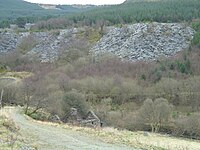
McConnel set about improving Bryn Eglwys to increase its output and in 1865 his company earmarked money for the construction of a narrow gauge railway connecting the quarry with the port of Aberdovey, and thence the Aberystwyth and Welsh Coast Railway. An Act of Parliament (28 and 29 Vict, cap cccxv) allowing the company to operate passenger trains as a public railway was given Royal Assent on 5 July 1865,[11][12] and the company's engineer, James Swinton Spooner, laid out plans for a relatively straight line climbing steadily from Towyn to the quarry and work quickly got underway.
Due to problems with inadequate loading gauge (with less than 2-foot clearance on either side, below the legal minimum), the doors on one side of each carriage were permanently barred and the track slewed off-centre beneath the bridges to allow adequate clearance at least on the side with doors, and to this day all carriages on the Talyllyn have doors on one side only. In October 1866 the railway began an unofficial, unauthorised passenger service; passengers were carried "at their own risk" and possibly free of charge until the line was officially sanctioned and opend in December 1866,[13] and the first purpose-built, steam-worked, narrow gauge public railway in Britain opened for service.[14]
Prosperity: 1866–1880s
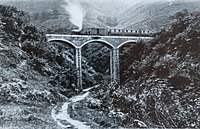
The railway opened with two locomotives, one carriage and several goods vehicles in use and was operated under a "one engine in steam" policy to ensure that two trains could not collide.[15] At the time of the line's opening, stations were provided at Pendre and Abergynolwyn. In 1867, the halt at Rhydyronen opened, followed by Brynglas and Dolgoch in 1873. Some time shortly after the opening of the railway a branch to Abergynolwyn village was provided. A steep cable incline dropped from the mineral line east of Abergynolwyn station to the village below, where a series of tram lines radiated. Coal, building materials and general goods were delivered down the incline and the contents of the village cesspits were hauled back up for disposal along the lineside.[15]
The railway used steam locomotives from the start, unlike its neighbour the horse-drawn Corris Railway, the original two engines bought from Fletcher, Jennings & Co. of Whitehaven in Cumberland,[16] and both are still in service 140 years on, although so many of their parts have been replaced down the years that much of their present-day component metal is not original. The Talyllyn's rare gauge is thought to have been adopted to match that of the Corris Railway,[17] and the line's two original steam locomotives were among the earliest engines built for such a narrow gauge. No. 1 Talyllyn is an 0-4-2ST (saddle tank) and No. 2 Dolgoch is an 0-4-0WT (well tank). The line carried slate from the quarry to the wharf at Tywyn and general goods along its length. Public passenger trains initially ran between Abergynolwyn, Dolgoch and Pendre stations only; quarrymen were carried on unofficial trains that continued on from Abergynolwyn to the foot of the Alltwyllt incline in Nant Gwernol gorge.[15]
Talyllyn is the model for Skarloey in the Thomas the Tank Engine books, and is mentioned by name at the end of one story.
By 1880, Bryn Eglwys employed 300 workers and was producing 8,000 tons of finished slate a year, all shipped by the railway.[8] Passenger traffic was substantial, rising from 11,500 passengers carried in 1867 to over 23,000 (roughly equivalent to 40,000 passenger journeys) in 1877.[18]
Declining fortunes: 1880s–1910
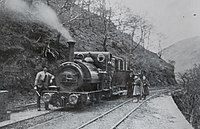
From the 1880s onwards the "Corris Railway Grand Tour" was a popular option with tourists. This used charabancs to link the Talyllyn and Corris railways via Tal-y-llyn Lake and Cadair Idris, returning on Cambrian Railways trains.[19] The last two decades of the 19th century saw a decline in the demand for slate and many smaller quarries fell on hard times, including Bryn Eglwys, where by 1890 production had halved to 4,000 tons a year.[8] In 1896, production at the Penrhyn Quarry stopped due to labour disputes so McConnel expanded production at Bryn Eglwys to take advantage of the sudden demand, aiming to maximising profits during the remainder of his lease, which was to expire in 1910. As McConnel's lease drew to its close and there was no prospect of a further lessee coming forward and work began on dismantling the quarry's equipment.[20]
Haydn Jones era: 1911–1950
The Bryn Eglwys quarry, the primary employer in the Abergynolwyn district, closed in 1910. Local landowner Henry Haydn Jones purchased the company in 1910, the same year he was elected to Parliament for Merioneth, and he reopened the quarry in January 1911[20] but without capital to invest he took shortcuts. A brief construction boom after the First World War saw production return to around 4,000 tons a year.[8] This time too saw an upsurge in holiday traffic and the Talyllyn had to supplement its formal passenger stock with slate wagons fitted with planks as seats.[21] An unusual tourist service offered by the railway was to hire a slate wagon, which would be left at Abergynolwyn, then at the end of the day the tourists would return to Towyn in the wagon under gravity. This service was discontinued in the early 1930s.[22] The additional income from the tourist trade defrayed some of the costs of operating the railway, but never enough for it to make a profit during Haydn Jones' ownership.
In 1946 the quarry suffered a significant collapse, was deemed unsafe and closed immediately. The railway continued to run trains on a shoestring budget. It avoided nationalisation the next year, possibly simply forgotten by officialdom.[23] On 2 July 1950 Haydn Jones died, and the line closed after the summer season, on 6 October 1950.[24]
Preservation
Rescue: 1951–1960
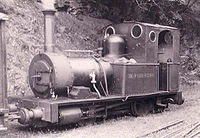
In the summer of 1950, the author and biographer Tom Rolt wrote a letter to the Birmingham Post newspaper suggesting that a rescue of the Talyllyn be undertaken. He received sufficient positive response for a meeting of interested enthusiasts to be held on 11 October 1950 at the Imperial Hotel in Birmingham. Around 70 people attended the meeting and Rolt proposed the formation of a committee to look into the acquisition of the railway. With the support of the meeting, the committee met for the first time on 23 October and immediately entered into negotiation with Haydn Jones' executors.[25]
The transfer of ownership to the committee was legally complex, but both parties agreed that all shares in the railway company would be transferred from Haydn Jones' estate to a new company called Talyllyn Holdings Ltd., whose board consisted of two directors from the executors and two from the committee. The transfer took place on 8 February 1951, at which point the newly formed Talyllyn Railway Preservation Society effectively took control of the railway and began raise funds and find further volunteers to help reopen the railway; by May nearly 650 members had joined the society.[26] The railway re-opened under the control of the Society for the first time on the Whit Monday bank holiday, 14 May 1951,[27] with trains running between Wharf and Rhydyronen stations. Regular trains began to run on 4 June and continued through the summer,[28] with David Curwen acting as the first Chief Mechanical Engineer.[27]
In 1950 the only working engine was Dolgoch, which needed a major overhaul. Two further steam locomotives were purchased from the recently closed Corris Railway in 1951 and named Sir Haydn and Edward Thomas respectively.
On 22 May 1957 the BBC produced a live outside broadcast from the railway, during which Wynford Vaughan Thomas and Huw Weldon commentated on a trip from Dolgoch to Abergynolwyn. The publicity from this broadcast drew substantial numbers of visitors to the railway that summer, with more than 57,500 passengers carried, and this increase in revenue in turn enabled the railway to continue to improve its infrastructure and provide tourists with a better experience.[29] The following year locomotive No. 1 Talyllyn returned to steam after an extensive overhaul.[30]
Extension to Nant Gwernol: 1969–1980
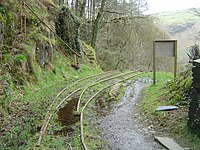
The preservation society had long held ambitions to extend the railway along the former mineral extension from Abergynolwyn to the foot of the Alltwyllt incline, and as early as 1959 work had begun to trace the owners of the land that the extension traversed. Planning began in the mid-1960s, but construction did not start until 1968 when the winding house for the Abergynolwyn village incline was demolished.[31] To bring the line up to passenger standards some of the curves needed to be eased, and this required blasting work, as the line runs on a narrow ledge on the hillside at this point.[32] The extension and new station at Nant Gwernol were opened on 22 May 1976 by Wynford Vaughan Thomas who drove in the ceremonial "golden spike" to complete the extension.[33] Despite this official opening ceremony, minor work still remained to bring the extension to the standard required to run regular passenger trains, but regular train services began on 29 May 1976.[34]
Work in the vicinity continued with the creation of footpaths connecting to the new station. A new footbridge was built crossing the Nant Gwernol gorge and connecting the station with the existing path on the east side of the river. After 1973, the peak year for passengers on the Talyllyn with 186,000 passenger journeys made,[35] numbers were to decline consistently until the 1990s.
Today
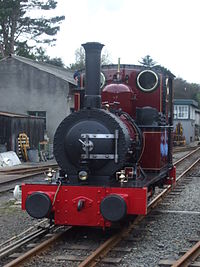
The Talyllyn Railway remains a successful and popular tourist attraction. The original 1860s locomotives and passenger stock still run regularly alongside the roster of more modern rolling stock. The railway is promoted as one of The Great Little Trains of Wales, a joint marketing scheme launched in 1970 that encompasses ten narrow gauge railways in the country, mostly found in north and mid Wales.[36][37] In 2006, nearly 51,000 passengers were carried.
In 2003 the railway employed 13 full-time staff, plus the equivalent of an extra six part-time staff in the summer and some 350 volunteers.
Special events
The railway operates a programme of special events throughout the year. These include the Have-A-Go Gala, Tom Rolt Steam and Vintage Rally, children's Duncan Days and Tywyn Victorian week. Since 1984 there has been an annual running event called Race the Train, which follows the railway track 7¼ miles from Tywyn to Abergynolwyn and back again.[38] The challenge is for runners to complete the 14½-mile cross country route faster than the train, which takes around 1 hour 45 minutes.
In fiction
The Talyllyn Railway is represented in the Railway Series books by the Reverend W Awdry and the spin-off TV series Thomas & Friends as the Skarloey Railway; most of the fictional locomotives are based on real-life equivalents. Awdry visited the line on a family holiday in the early days of preservation and became involved as a volunteer soon afterwards. Several of the stories in The Railway Series come from his real-life experiences at the Talyllyn, and some of the books contain full-page illustrations of Talyllyn locomotives.[39] Skarloey himself is based on Talyllyn and Sir Handel on Sir Hayden.
The preservation of the Talyllyn Railway by volunteers was the inspiration for the 1953 film The Titfield Thunderbolt,[40] an Ealing Studios comedy about a group of villagers attempting to run a service on a disused branch line after closure. T E B Clarke, the script-writer for the film, had heard about the preservation of the Talyllyn and spent a day on the railway in 1951, and some of the early incidents in preservation were incorporated into the film. In the book Railway Adventure Tom Rolt recalled that he had hoped the film might be produced on the Talyllyn,[41] but it was eventually filmed on the recently closed Camerton branch of the Bristol and North Somerset Railway branch line along the Cam Brook valley in Somerset.[42]
Outside links
| ("Wikimedia Commons" has material about Talyllyn Railway) |
- Talyllyn Railway website
- Narrow Gauge Railway Museum
- Railway with a Heart of Gold, a slightly tongue-in-cheek documentary about the railway, filmed in the early 1950s by American filmmaker Carson Davidson
References
- ↑ Mitchell and Eyres, 2005 page 7
- ↑ Boyd 1988, page 44
- ↑ Rolt 1965, page 50
- ↑ Thomas 2002, page 32
- ↑ Ransom 1996, page 139
- ↑ Johnson 1999, page 27
- ↑ Boyd 1965, page 61–62
- ↑ 8.0 8.1 8.2 8.3 Richards 1999, page 195
- ↑ Boyd 1965, pages 62–63
- ↑ Boyd 1988, page 9
- ↑ Boyd 1988, page 45
- ↑ Potter, page 11
- ↑ Rolt 1998, page 13
- ↑ Boyd 1965, pages 68–70
- ↑ 15.0 15.1 15.2 Boyd 1965, page 71
- ↑ Rolt 1965, pages 82–83
- ↑ Rolt 1998, pages 5–6
- ↑ Boyd 1965, page 118
- ↑ Rolt 1998, pages 24–25
- ↑ 20.0 20.1 Boyd 1965, pages 72–73
- ↑ Ransom 1996, page 130
- ↑ Boyd 1965, pages 116–117
- ↑ Boyd 1965, pages 73–74
- ↑ Boyd 1965, page 74
- ↑ Rolt 1965, pages 52–53
- ↑ Rolt 1965, pages 54–55
- ↑ 27.0 27.1 Potter, page 78
- ↑ Rolt 1965, page 56
- ↑ Rolt 1965, pages 61–62
- ↑ Mitchell and Eyres, 2005 page 25
- ↑ Thomas 2002, page 34
- ↑ Bate 2001, page 181
- ↑ Bate 2001, pages 184–185
- ↑ Bate 2001, page 189
- ↑ Bate 2001, page 169
- ↑ Bate 2001, page 157
- ↑ Yarborough, Bruce. "The Great Little Trains of Wales website". Great Little Trains of Wales. http://www.greatlittletrainsofwales.co.uk. Retrieved 6 April 2008.
- ↑ "Race the Train website". Tywyn Rotary Club. http://www.racethetrain.com/. Retrieved 6 April 2008.
- ↑ Potter, page 89
- ↑ Huntley 1969, page 77
- ↑ Rolt 1998, page 115
- ↑ Castens, page 5
Books
- Bate, J.H.L. (2001). The Chronicles of Pendre Sidings. RailRomances. ISBN 1-900622-05-X.
- Boyd, James I.C. (1965). Narrow Gauge Railways in Mid Wales. Oakwood Press. ISBN 0-85361-024-X.
- Boyd, James I.C. (1988). The Tal-y-llyn Railway. Wild Swan Publications Ltd. ISBN 0-906867-46-0.
- Castens, Simon (2001). On the Trail of The Titfield Thunderbolt. Thunderbolt Books. ISBN 0-9538771-0-8.
- Cozens, Lewis (1948). The Tal-y-llyn Railway. Privately printed.
- Goddin, Geoff (September 2002). "Whose Heritage Railway is it? A Study of Volunteer Motivation" (PDF). Japan Railway & Transport Review 32: 46–49. http://www.jrtr.net/jrtr32/pdf/f46_god.pdf. Retrieved 1 May 2009.
- Holmes, Alan (2009). Talyllyn Revived. The Talyllyn Railway. ISBN 978-0-900317-07-1.
- Household, H.G.W. and Eldson, O. (June 1926). "The Tal-y-llyn Railway" (PDF). Railway Magazine 58: 431–435. http://www.ukrailarchive.org/ngr/rm06-1926-431.PDF. Retrieved 1 May 2009.
- Huntley, John (1969). Railways in the Cinema. Ian Allan.
- Johnson, Peter (1997). The Heyday of the Welsh Narrow Gauge. Ian Allan. ISBN 0-7110-2511-8.
- Johnson, Peter (1999). Welsh Narrow Gauge: a view from the past. Ian Allan. ISBN 0-7110-2654-8.
- Johnson, Peter and Weaver, Rodney (1987). Great Preserved Locomotives: Talyllyn Railway No 1 Talyllyn & No 2 Dolgoch. Ian Allan. ISBN 0-7110-1711-5.
- Mitchell, David J. and Eyres, Terry (2005). The Talyllyn Railway. Past and Present Publishing Ltd. ISBN 1-85895-125-9.
- Potter, D. (1990). The Talyllyn Railway. David St John Thomas. ISBN 0-946537-50-X.
- Ransom, P.J.G (1996). Narrow Gauge Steam: Its origins and world-wide development. Oxford Publishing Co. ISBN 0-86093-533-7.
- Richards, Alun John (1999). The Slate Regions of North and Mid Wales, and their Railways. Carreg Gwalch. ISBN 0-86381-552-9.
- Rolt, L.T.C. (1998). Railway Adventure. Sutton Publishing. ISBN 0-330-02783-2.
- Rolt, L.T.C. (ed.) (1965). Talyllyn Century. David & Charles.
- Thomas, Cliff (2002). The Narrow Gauge in Britain and Ireland. Atlantic Publishing. ISBN 1-902827-05-8.
- Woodcock, G. George (September 1938). "The Tal-y-llyn Railway" (PDF). Railway Magazine 83 (495): 197–200. http://www.ukrailarchive.org/ngr/rm1938-83-197.PDF. Retrieved 1 May 2009.
